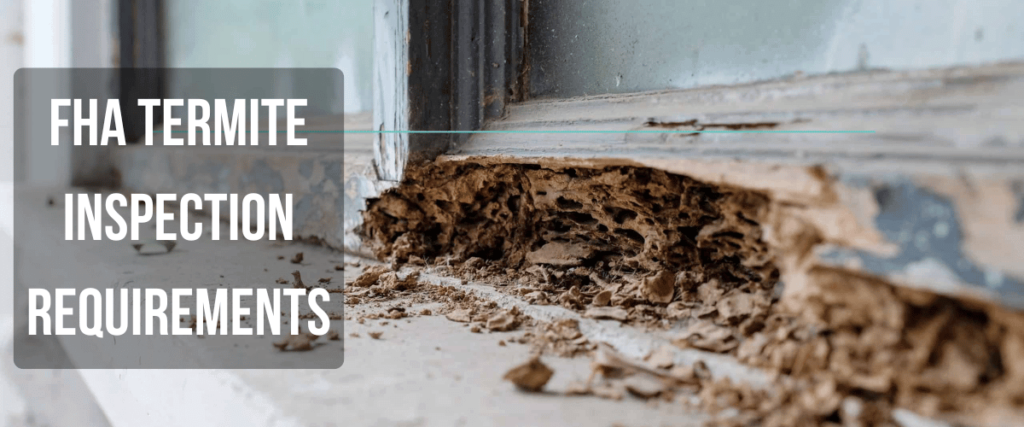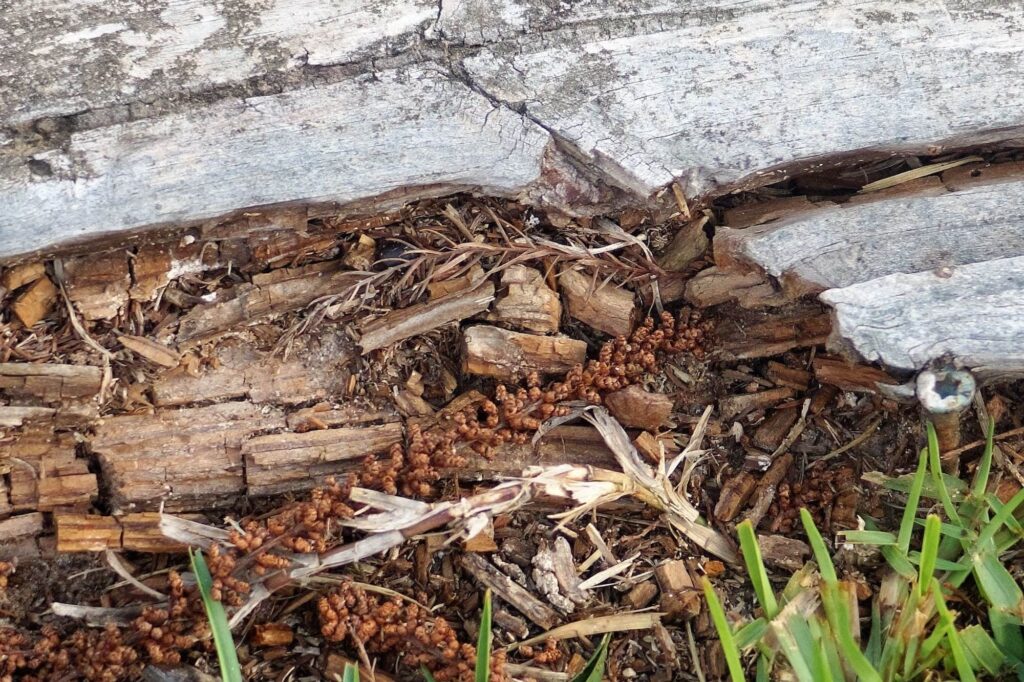The Federal Housing Administration has specific requirements for termite inspections when an FHA loan is being used to buy a home. These requirements are outlined in HUD Handbook 4000.1, also known as the Single Family Housing Policy Handbook.
Below you’ll find a basic overview of FHA inspection requirements for termites and other wood-destroying insects, including exceptions for new construction in some states. Please refer to official guidelines if you have questions, or to learn more about this subject.
Termite Inspection Requirements for FHA Loans
The main thing to know is that a full termite inspection isn’t always required on home purchases that are financed through the FHA mortgage program — especially when it comes to new construction. Some borrowers believe that termite inspections are mandatory in all FHA loan scenarios. But that’s not true.

Part II of the aforementioned handbook covers appraiser and property requirements for FHA home purchase loans. Among other things, it specifies what the appraiser must look for with regard to termite infestation on homes.
Here’s a direct quote from that section of the handbook:
“The Appraiser must observe the foundation and perimeter of the buildings for evidence of wood destroying pests.”
So that tells us where the appraiser must look for termites when evaluating a property — primarily, the foundation and perimeter of buildings. The handbook goes on to explain that it doesn’t have to be a complete and comprehensive inspection:
“The Appraiser’s observation is not required to be at the same level as a qualified pest control specialist.”
Here’s what the appraiser must do if he or she encounters signs of termites or other wood-destroying insects:
If the appraiser finds “evidence or notification of infestation, including a prior treatment,” he or she must mark the appropriate box under the “Improvements” section of the appraisal report. Another key requirement: The appraiser must then make the appraisal subject to inspection by a qualified pest control specialist.
That last part is important. It means that a professional termite / pest inspection service must be brought in to further inspect the property.
But again, this is only in cases where the appraiser finds evidence of wood-destroying insects such as termites. If he or she does not encounter such evidence, then further inspection is usually not required and the loan process can move forward.
What the Mortgage Lender Must Do
The HUD handbook also outlines termite-related requirements for the mortgagee / mortgage lender. But again, these are only in cases where the home appraiser has found evidence of an infestation and “flagged” it in the appraisal report.
Where it talks about underwriting the property, the handbook states:
“For existing Properties, the Mortgagee must confirm that the Property is free of wood destroying insects and organisms [such as termites]. If the appraisal is made subject to inspection by a qualified pest control specialist, the Mortgagee must obtain such inspection and evidence of any required treatment to confirm the Property is free of wood destroying insects and organisms.”
So, if the home appraiser flags the property for having signs of a termite inspection (or other damaging insects), the property must then be inspected by a professional pest control company. The pest control specialist would then treat the home, if necessary, to remove the wood-destroying insects.
The mortgage lender must then ensure that the property is free of such pests. They might do this by obtaining a treatment report from the pest control specialist, or similar evidence.
Those are the basic termite inspection requirements for FHA loans on existing homes. Now, let’s take a look at the specific rules for new construction, including some state-by-state exceptions to these rules.
Special Requirements for New Construction
There are also some termite-related requirements for new construction (newly built homes), and these are found in a different part of the handbook.
Within the context of FHA loans, HUD generally defines “new construction” to include proposed construction, properties that are under construction, and properties that have existed for less than one year.
There are some termite-related documents required for “new construction” that is being financed with an FHA loan (with maximum financing). They are:
- Wood Infestation Report. This document is typically required for most new properties, unless the home being purchased is “located in an area of no to slight infestation as indicated on HUD’s ‘Termite Treatment Exception Areas’ list.” (See table below.)
- Form HUD-NPMA-99-A. This document (a.k.a., the Subterranean Termite Protection Builder’s Guarantee), is required for all new construction according to current HUD guidelines.
- Form HUD-NPMA-99-B. This document (a.k.a., the New Construction Subterranean Termite Service Record) is typically required when the property has been treated with a soil chemical termiticide.
* See the table below for exceptions areas for new construction.
The handbook goes on to state that:
“If the building is constructed with steel, masonry or concrete building components with only minor interior wood trim and roof sheathing, no treatment is needed. The Mortgagee must ensure that the builder notes on the form that the construction is masonry, steel, or concrete.”
Termite Treatment Exception Areas by State
Here are the “Termite Treatment Exceptions Areas” for new construction, as per HUD Handbook 4000.1.
| State | Termite Treatment Requirement |
| Alaska | Not required in any county. |
| Colorado | Not required in Clear Creek, Eagle, Gilpin, Grand, Jackson, Moffat, Routt, and Summit Counties. Required in any other county. |
| Idaho | Not required in any county. |
| Maine | Required in York and Cumberland counties. Not required in any other county. |
| Michigan | Not required in Alcona, Alger, Alpena, Antrium, Arenac, Baraga, Bay, Benzie, Charlevoix, Cheboygan, Chippewa, Clare, Crawford, Delta, Dickinson, Emmet, Gladwin, Gogebic, Grand Traverse, Houghton, Huron, Iosco, Iron, Isabella, Kalkaska, Keweenaw, Leelanau, Luce, Mackinac, Marquette, Menominee, Midland, Missaukee, Montmorency, Ogemaw, Ontonagon, Osceola, Oscoda, Otsego, Presque Island, Roscommon, Saginaw, Sanilac, Schoolcraft, Tuscola, and Wexford. Required in any other county. |
| Minnesota | Not required in Becker, Beltrami, Clay, Clearwater, Cook, Grant, Hubbard, Itasca, Kittson, Koochiching, Lake, Lake of the Woods, Mahnomen, Marshall, Norman, Otter Tail, Pennington, Polk, Roseau, Stevens, Traverse, Wadena, and Wilkin Counties. Required in any other county. |
| Montana | Not required in Blaine, Broadwater, Carbon, Cascade, Chouteau, Daniels, Fergus, Gallatin, Glacier, Golden Valley, Hill, Judith Basin, Lewis and Clark, Liberty, Meagher, Musselshell, Park, Petroleum, Phillips, Pondera, Roosevelt, Sheridan, Stillwater, Sweet Grass, Teton, Toole, Valley, Wheatland, and Yellowstone Counties. Required in any other county. |
| New Hampshire | Not required in Grafton, Carroll, and Coos Counties. Required in any other county. |
| New York | Not required in Clinton, Essex, Franklin, St Lawrence, Niagara and Orleans. Required in any other county. |
| North Dakota | Not required in any county. |
| Oregon | Not required in any county. |
| South Dakota | Not required in Bennett, Brown, Buffalo, Butte, Campbell, Corson, Custer, Day, Dewey, Edmunds, Faulk, Haakon, Hand, Harding, Hughes, Jackson, Jones, Lawrence, Marshall, McPherson, Meade, Mellette, Pennington, Perkins, Potter, Roberts, Shannon, Spink, Stanley, Sully, Walworth, and Ziebach Counties. Required in any other county. |
| Utah | Not required in Daggett, Morgan, Summit, and Wasatch. Required in any other county. |
| Vermont | Not required in Franklin, Grand Isle, Orleans, Essex, Chittenden, Lamoille, Caledonia, Washington, Addison and Orange. Required in any other county. |
| Washington | Not required in any county. |
| Wyoming | Not required in Fremont, Hot Springs, Lincoln, Park, Sublette, Sweetwater, Teton, and Uinta. Required in any other county. |
| Remainder of states | Required. |
Why the FHA Is Concerned About Termites
As you can see, the Federal Housing Administration (FHA) puts a lot of emphasis on termite inspections for properties financed with FHA home loans. That’s because of the potential damage these insects can do to a home, and the resulting costs.

Termites are a type of “wood destroying insect,” and they truly live up to the name. Termites are notorious for feeding on wood, which can lead to structural damage over time when left unchecked. This damage can compromise the integrity of the property, posing safety hazards and reducing its value.
A video of termites slowly destroying a home (PBS.org)
The cost of repairing termite damage can be substantial, often running into thousands of dollars or more. Even a home with a brick or stone exterior will have a lot of wood inside the structure (studs, joists, floorboards, rafters, etc.). And a typical termite colony might include hundreds of thousands of insects.
Put these two things together, and you have a recipe for destruction.
By requiring termite inspections, the FHA aims to protect both the lender and the borrower. Lenders want to ensure that the properties they finance are in sound condition. Borrowers benefit from knowing the true condition of the property they are purchasing, allowing them to make informed decisions.
Where to learn more: More detailed termite inspection requirements for FHA loans can be found in HUD Handbook 4000.1. If you have any questions about them, you can send them to the Federal Housing Administration’s resource center. You can also review their list of frequently asked questions located at www.hud.gov/answers.
